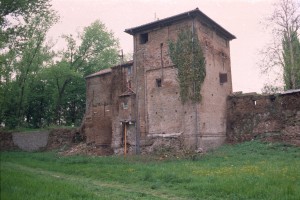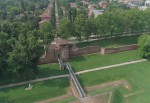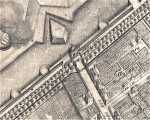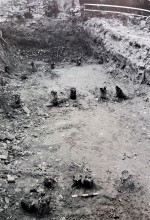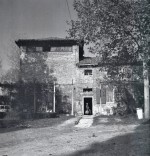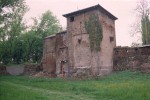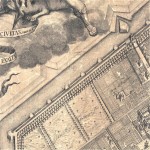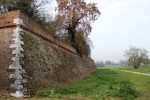Porta degli Angeli
An armed stronghold of the northern section of the city walls, Porta degli Angeli and its square tower were already in use at the turn of the sixteenth century, even if it was given its final appearance in 1525-1526.
Historical notes about the gate, improperly known as Ca’ dal Boia (The Executioner's House)
Located at the end of the ancient Via degli Angeli, this gate was the only northern passage in the fortified walls built between 1493 to 1505 around the large "Terra Nova” - the area of urban expansion better known as the Addizione Erculea (Erculean Addition) in honour of Duke Ercole I of Este.
History has it that Cesare, the last Este duke before control over Ferrara went to the Pope, left the city from this gate in January 1598. It is said that, immediately afterwards, the northern archway was walled up to commemorate the event. This is, of course, the stuff of legend: studies and archaeological digs carried out on the building lead us to believe that the gate was in use at least until the end of the seventeenth century, even if in alternating phases.
The original quadrangular watch tower was changed a number of times between 1519 and 1526, and these modifications continued over the course of the centuries in accordance with its changing functions: it went from defensive structure to a toll barrier during the eighteenth century, before becoming a slaughterhouse for pigs in 1820 (the small, circular external well and part of the walls around the stalls are still visible). Subsequently, it served as a gunpowder room, and from 1894 until the early 1980s it was used as housing.
To this day, locals still improperly refer to this gate as the Ca’ del Boia (the House of the Executioner), a name solidified in the collective memory because the building was used as a slaughterhouse for pigs, whose agonizing cries remained imprinted on popular oral traditions, creating a sinister, unsettling reputation for the site.
Restoration work was carried out here from 1984 to 1991 by the Ferrara Civic Museums of Ancient Art, entrusted with this task by the Environmental and Architecture Heritage Superintendency as part of the regional FRIET project titled ‘Wall-Park. Cultural and Environmental Restoration’. During the restoration, the building's old forms and structures came to light, including the southern entrance arch (which, along with the northern arch, was walled up in the nineteenth century), the trachyte stone threshold marked by the grooves of cart wheels, the flooring which features Euganean trachyte paving stones and bricks laid edge-on, as well as traces of battlements on the external wall of the late sixteenth-century building next to the tower, used as the gatehouse.
The excavation works carried out in the entrenchments (which were once filled with water) uncovered a number of large poles from the wooden bridge that has long since disappeared (the current bridge is made of metal). They connected the gate to the nearby arrow-shaped ravelin built in the late sixteenth century, upon which guns and firearms where placed. –; Demolished in 1859, it has since been restored. The ravelin was also used for 'some customs inspections and, in particular, careful preliminary checks of those who wanted to cross the bridge and enter the city, obviously after having passed the second checkpoint made up of soldiers guarding the gate. These restrictive regulations, used at other city gates also (those where the most people, animals and goods passed) were particularly effective during epidemics and especially in preventing the city from being infiltrated with spies and saboteurs’. (Scafuri 2003, p. 42).
The guardhouse on the right is accessible from the central body of the tower. Also, thanks to a modern metal spiral staircase, visitors can now head to the upper level to take in the view of the curtain wall and part of the allure. After a small area with loopholes, visitors can then reach the very top of the tower, with its full panoramic view, especially towards Giorgio Bassani Park.
Owned by the municipality, Porta degli Angeli is often used for numerous events and cultural initiatives throughout the year, especially exhibitions, concerts and other musical happenings.
Bibliography
- Alessandra Farinelli Toselli, Fra città e campagna: la Porta degli Angeli fra storia e tradizione storiografica in Ferrara 1492-1992. La strada degli Angeli e il suo Quadrivio. Utopia, disegno e storia urbana, Corbo, Ferrara 1992
- Francesco Scafuri, Itinerario attorno le mura di Ferrara, tra arte militare e innovazioni urbanistiche, in Alessandra Farinelli Toselli, Francesco Scafuri (a cura di), Ferrara VII-XX secolo. Giardini e fortificazioni, Centro Stampa del Comune, Ferrara 1993, pp. 76-96
- Maria Teresa Gulinelli, Porta degli Angeli, in Anna Maria Visser Travagli (a cura di), Ferrara nel Medioevo. Topografia storica e archeologia urbana, Grafis, Bologna 1995, pp. 121-124
- Maria Teresa Gulinelli, Ricerche archeologiche nel tratto settentrionale delle Mura Estensi, in Maria Rosaria Di Fabio (a cura di), Le Mura di Ferrara. Storia di un restauro, Minerva, Bologna 2003
- Francesco Scafuri, Le mura di Ferrara. Un itinerario attorno alla città, tra storia ed architettura militare, in Maria Rosaria Di Fabio (a cura di), Le mura di Ferrara. Storia di un restauro, Minerva, Bologna 2003
- Anna Maria Visser Travagli, Il contributo dell'archeologia al restauro delle Mura di Ferrara, in Maria Rosaria Di Fabio (a cura di), Le Mura di Ferrara. Storia di un restauro, Minerva, Bologna 2003
- Maurizio Bernardi, Michele Pastore, Il restauro delle Mura: gli interventi, in Maria Rosaria Di Fabio (a cura di), Le mura di Ferrara. Storia di un restauro, Minerva, Bologna 2003
Sitography
- http://servizi.comune.fe.it/8120/porta-degli-angeli
- http://www.cronacacomune.it/notizie/25179/porta-degli-angeli-2015.html
- https://www.facebook.com/pages/category/Community/Porta-degli-Angeli-detta-impropriamente-casa-del-boia-194615390579449/
Fototeca
Related Themes
Compiling entity
- Assessorato alla Cultura e al Turismo, Comune di Ferrara

